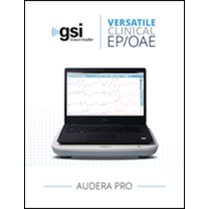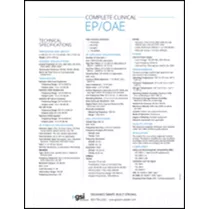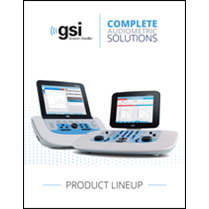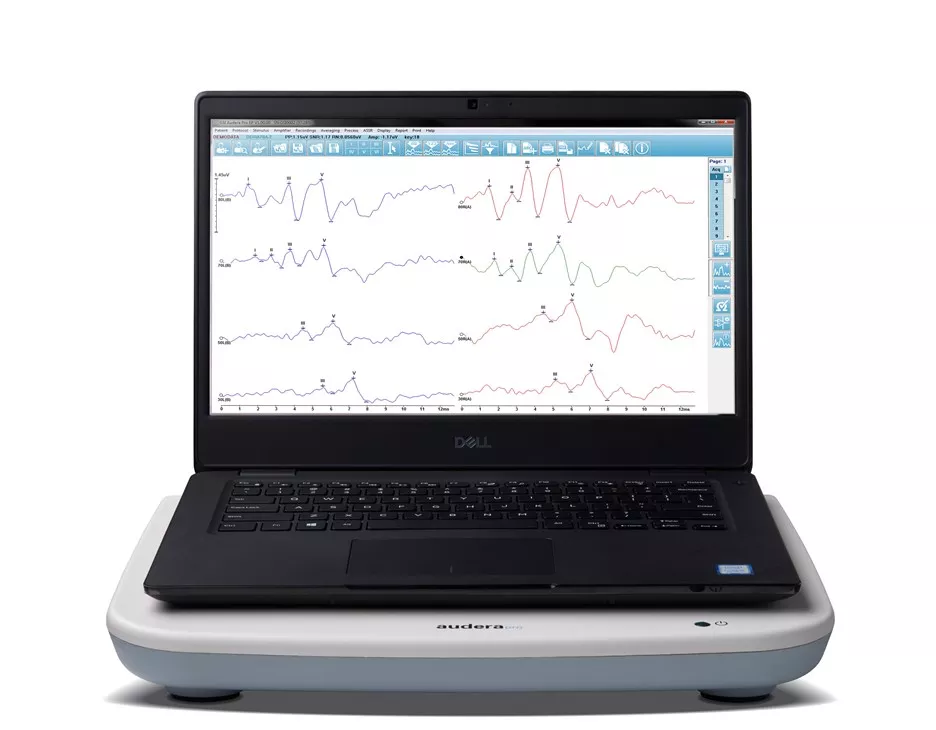
Audera Pro
VERSATILE CLINICAL EP/OAE
The GSI Audera Pro™ EP/OAE system is a compact yet versatile device, capable of performing all standard evoked potential tests. Depending on the modality license, ASSR (auditory steady state responses) and OAE (otoacoustic emissions) can also be completed. The Audera Pro is the next generation to the well-known GSI Audera™ and comes with significant updates to support the demands of any busy practice. Some of the featured new tests include: P300/MMN, ASSR Binaural testing, TEOAE, and Speech Stimuli for ABR. The hardware has been updated to provide a smaller footprint, an integrated pre-amplifier, lightweight cables, and the GSI OAE probe. The system also has modern waveform analysis tools such as Area Ratio for ECochG, application of digital filters, the ability to split alternating waveform into rarefaction and condensation components, cross correlation of waveforms, and automatic SNR (Signal-to-Noise Ratio) and RN (Residual Noise) calculation. The Audera Pro is the perfect choice for clinics to comprehensively evaluate, identify, document, and diagnose auditory and vestibular disorders on all patient populations.
FREQUENTLY ASKED QUESTIONS
Q. What configurations are available with the GSI Audera Pro?
A. Available configurations on the Audera Pro include AEP only, AEP and ASSR, AEP and TEOAE/DPOAE, TEOAE/DPOAE only, and a full configuration that includes all test modalities AEP/ASSR/TEOAE/DPOAE.
Q. What tests can be performed with the AEP test modality?
A. The following tests are available with the AEP test modality: ECochG, ABR, MLR, LLR and SN10. In addition, eABR, P300, MMN as well as oVEMP/cVEMP protocols are included.
Q. Is it possible to record bone conduction ASSR?
A. Yes. It is possible to record ASSRs with all AEP transducers, including insert earphones, headphones, bone oscillator, and the optional amplified speakers
Q. What tests can be performed with the Audera Pro OAE system?
A. The following tests are available: screening (pass/refer) protocols, diagnostic protocols, spontaneous OAE, and DP input/output functions.
Q. Are there objective tools for analyzing waveforms?
A. The Audera Pro includes a variety of objective analysis tools such as cross correlation, SNR, and RN. SNR and RN are objective tools that assist the clinician in determining the presence or absence of a response. Cross correlation is a statistical tool that provides an objective estimate of the similarity of two waveforms. The higher the correlation value, the more similar the waveforms are with “1” being perfect correlation. Signal to Noise Ratio (SNR) is the ratio of the response from the patient (the ABR) vs the noise such as the EEG or EMG activity. Residual Noise (RN) is the amount of noise that remains in the response. When a response is present, the SNR should increase, and the RN should decrease during the collection as more sweeps are averaged. The Audera Pro displays RN and SNR for the active waveform as well as saved waveforms.

COMPREHENSIVE BATTERY OF TEST TYPES
The GSI Audera Pro comes equipped with a comprehensive battery of evoked potentials and otoacoustic emissions test types. Optional modality licenses may be purchased, allowing you to perform a combination of different tests: AEP, ASSR, DPOAE, and TEOAE.

MULTIPLE ANALYSIS TOOLS
The Audera Pro includes a variety of objective analysis tools such as cross correlation of two waveforms, real time signal to noise ratio (SNR), and residual noise (RN) estimates to assist the clinician in validating test data.

EFFICIENT DATA COLLECTION
Modules of the Audera Pro feature predefined protocols and normative data. On screen options allow for changes in real time. Customized protocols may be added to meet individual testing needs.

LARGER AMPLITUDE WITH CE-CHIRP
Save time and increase clinical confidence by using the CE-Chirp and CE-Chirp Octave Band stimuli, which have been shown to result in ABR amplitudes that are up to two times larger than traditional test stimuli.

ORGANIZED DATA
Reporting is clear and concise, allowing test results to be easily organized, combined, and interpreted. All test modules on the Audera Pro feature data organization designed with efficiency in mind. This includes multiple pages available in a single report to include ABR, ASSR, and OAE data.
KEY SYSTEM FEATURES
1. ARRAY OF SETUP OPTIONS
The system includes a comprehensive battery of evoked potentials test types including ECochG, ABR, MLR, LLR, SN10, P300/MMN, ASSR, and eABR.
2. STATISTICAL CROSS CORRELATION
Quickly obtain an objective estimate of the similarity of two waveforms. The higher the correlation value, the more similar the waveforms.
3. SPLITTING ACTIVE RECORDING
Collect a waveform using alternating polarity and split into rarefaction and condensation waveforms.
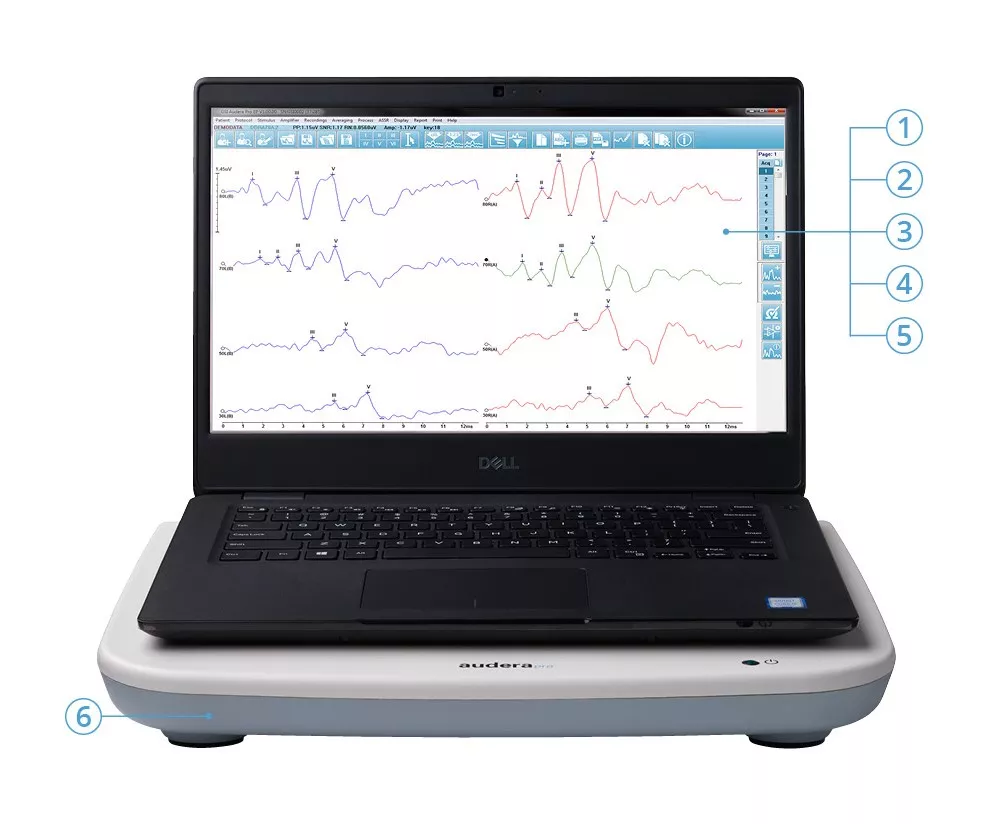
4. DIGITAL FILTERING
After a waveform has been collected, digital high-pass and low-pass filters can be applied to the saved waveform.
5. STIMULI OPTIONS
The Audera Pro gives you options with classic test stimuli of clicks and tone bursts with the added benefit of the CE-Chirp, CE-Chirp Octave Band, and speech stimuli.
6. SMALL AND CONFIGURABLE FOOTPRINT
With a small and sleek footprint, the Audera Pro may be placed in a cradle, underneath a laptop, or mounted on the wall.
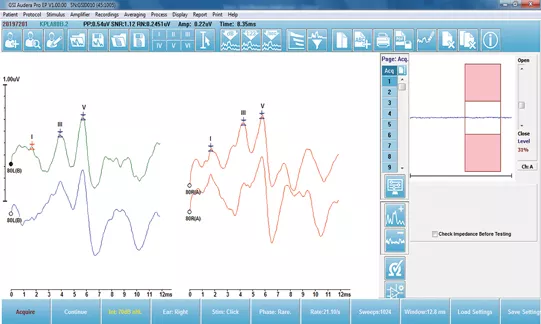
EP
The following tests are available: ECochG, ABR, MLR, LLR, and SN10. Also included are P300 and MMN protocols, eABR, traditional test stimuli of click and tone bursts, CE-Chirp and CE-Chirp Octave Bands, and speech stimuli.
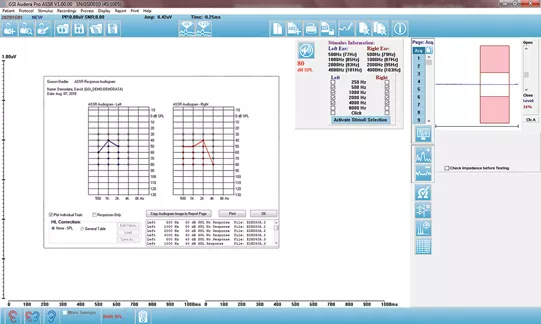
ASSR
Test stimuli include pure tones of 250, 500, 1000, 2000, 4000, and 8000 Hz. Present up to four frequencies in both ears at the same time for a total of eight frequencies.
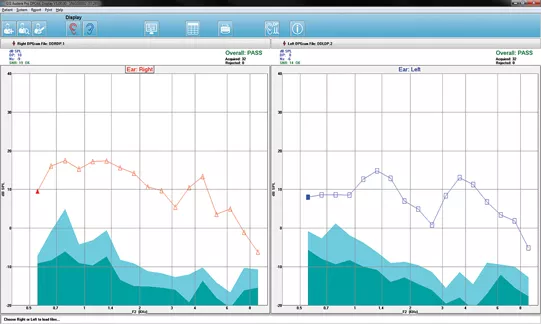
DPOAE
The following tests are available with DPOAE: screening (pass/refer) protocols, diagnostic protocols, customizable protocols, and DP input/output functions.

TEOAE
The following tests are available with TEOAE: screening (pass/refer) protocols, customizable protocols, and spontaneous OAE (SOAE).



